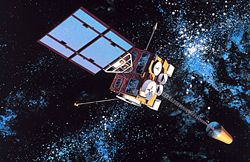 The GOES-15 satellite during pre-launch processing. | |
| Names | GOES-P GOES-15 (before September 22, 2023) |
|---|---|
| Mission type | Weather satellite |
| Operator | NOAA / NASA |
| COSPAR ID | 2010-008A |
| SATCAT no. | 36411 |
| Mission duration | 10 years (planned) Elapsed: 15 years, 8 months, 9 days |
| Spacecraft properties | |
| Spacecraft type | GOES-N series |
| Bus | BSS-601 |
| Manufacturer | Boeing ITT Corporation |
| Power | 2.3 kilowatts from solar array |
| Start of mission | |
| Launch date | 4 March 2010, 23:57 UTC |
| Rocket | Delta IV-M+(4,2) |
| Launch site | Cape Canaveral, SLC-37B |
| Contractor | United Launch Alliance |
| Orbital parameters | |
| Reference system | Geocentric |
| Regime | Geostationary |
| Longitude | 62° East |
| Semi-major axis | 42,166 kilometres (26,201 mi) |
| Perigee altitude | 35,791.0 kilometres (22,239.5 mi) |
| Apogee altitude | 35,800.4 kilometres (22,245.3 mi) |
| Inclination | 0.2° |
| Period | 1,436.2 minutes |
EWS-G2 (Electro-optical Infrared Weather System Geostationary) [1] is a weather satellite of the U.S. Space Force, formerly GOES-15 (also known as GOES-P before becoming operational). The spacecraft was constructed by Boeing, and is the last of three GOES satellites to be based on the BSS-601 bus. It was launched in 2010, while the other BSS-601 GOES satellites—GOES-13 and GOES-14—were launched in May 2006 and June 2009 respectively. [2] It was the sixteenth GOES satellite to be launched.

